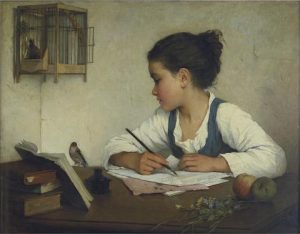 It cannot be repeated often enough that there is no single right way to write a novel (or to compose a symphony or design a house). All these artistic endeavors require certain elements (plot, characters, tension rising to a climax, or motif and variations, harmony, contrast, or foundation, walls, plumbing, etc.) They vary in the point in the creative process at which those crucial elements must be in place, of course. Within those parameters, there’s a great deal of flexibility that allows for individual differences. What matters is not when a writer nails down the turning points, but that they are present and in balance with the rest of the book when it ends on the editor’s desk.
It cannot be repeated often enough that there is no single right way to write a novel (or to compose a symphony or design a house). All these artistic endeavors require certain elements (plot, characters, tension rising to a climax, or motif and variations, harmony, contrast, or foundation, walls, plumbing, etc.) They vary in the point in the creative process at which those crucial elements must be in place, of course. Within those parameters, there’s a great deal of flexibility that allows for individual differences. What matters is not when a writer nails down the turning points, but that they are present and in balance with the rest of the book when it ends on the editor’s desk.
Many writers attempt their first novels by the “seat-of-the-pants” method, that is, writing whatever pops into their heads. Sometimes they end up with dead ends (disguised as “writer’s block”) and don’t finish the work. Other times, they do finish, only to discover (either through their own perceptions or feedback from others) that the book has significant problems. So they write another draft and go through the same process until either the story works or they become so frustrated they give up, or they refuse to accept further critiques and self-publish it.
There’s nothing inherently wrong with such a spontaneous approach to the first draft. A good deal of the pleasure of writing is in discovery, in not knowing what will come next as the adventure unfolds. This is how children play. It does require a separate editorial, self-critical phase, at least for most of us. That’s neither good nor bad, it’s just part of the process. If you want to “pants” your first draft, you accept that you’re going to have to revise. Maybe a little, maybe a lot. Some writers loathe revision. I happen to love it.
At some point, it occurs to many of us that if we maybe thought about what was going to happen in our novel and how we were going to portray it, that we might save ourselves a bit of revision time. We might even jot down a few notes, reminding ourselves that this is just a tentative sketch and that nothing is carved in granite. We may and most certainly do change our minds when we discover that the actual story has diverged significantly from our strategy. I’ve been known to rework my notes, negotiating the borderlands between spontaneous writing and ill-thought-out plan.
Some writers never go any farther with outlining. They decide it’s not working for them, whereas it is actually not working period. Outlines help because they are a place where problems with story elements can be worked out in a relatively short time and wordage. They reduce the number of dead ends, plot holes, and inconsistencies in motivation. But in order to realize the benefits of outlining (or planning, if you’re allergic to the word outline), they require concentrated and creative problem-solving.
Outlining—proper, thoughtful outlining–is exhausting. For one thing, it’s concentrated. A typical outline is 5 to 10 single-spaced pages, maybe 2000-5000 words, summarizing a work that will be 100,000 words when completed. That’s an immense amount of thought crammed into very few pages. For another thing, the actual writing of a story can generate its own positive-energy loops. You get excited by an idea that pops up, or a character takes on a life of her own and runs away with the story, or some lovely phrase or bit of dialog strikes you as so wonderful, it makes your heart sing. These moments are precious and also rare enough in actual writing. I’d venture that they are nonexistent in outlining.
So outlining is energy-draining and tedious. Why then do some writers swear by it? For one thing, as I mentioned above, when done properly it saves time. For a new writer, struggling to learn the craft and working on spec, this may not seem like such a big advantage. For a writer trying to earn a living, it can make the difference between completing one book every three years and managing two or three per year. Most established writers who are able to sell “on proposal” have no choice. Editors (and agents) expect synopses (which are not exactly the same as outlines, but are interchangeable for this discussion) and sample chapters.
Outlines, like pitches and queries, are also the occasion of dread in the minds of writers because they require a different skill set than actual story writing. Pitches and queries are marketing tools. Outlines are blueprints, not novels themselves. When I myself have to write one, I go around muttering, “If I could have tell the story in 10 pages, I wouldn’t have to write 500! Growl-growl-growl!” I have to patiently re-remind myself that I wasn’t born knowing how to do this, that I do it infrequently enough to lose whatever facility I gain each time, and that I cannot do it quickly or casually. For every element I write down, I will most likely need to get up, pace, take the dog for a walk, mull it over in a bubble bath, and then come back with a deeper insight into what the story needs.
I think of composing the outline as layering the story, but with filo dough, not bricks and mortar. I start with whatever grabs me—an idea, a character, a situation, some bizarre twist of events, or sometimes even just an emotional tone. Then I play around with Would it work this way? How can I jack up the risks? What terrible thing will result if this other thing does not happen (and then that’s what I put in, of course)? I almost always realize that this won’t work and that won’t work, or I need another character to put sand in the gears, or the danger just isn’t grave enough to justify all the hoopla.
This leads me to what may be the most valuable gift of careful outlining: it gives me a chance to set the stakes, to “build in” escalating drama, and to plan out how I’m going to parallel the hero’s emotional journey with her outer adventures. In other words, to shape the overall dramatic story arc so I will know where I am and what needs to be going on at every stage. Some writers like to use terms like plot point, midpoint empowerment, climax, etc. I like to draw flow charts and diagrams. It doesn’t matter what jargon describes the strategy; what’s important is that I have one.
For all my enthusiasm for outlines, gained over three decades of exploring all the ways to do it wrong, I also appreciate the importance of spontaneous writing. I don’t approach novels in this way, but I think my creative spirit would be the poorer if I did not have some way of following my own lighthearted inclinations through a story. This is one reason why I continue to write short fiction. For me, it provides a playground where I don’t have to think about structure or rules, I can just flow with whatever wacky notions come to me. Daydreaming is like this, only even less structured. I’ve never written fanfic, but I know many professional authors who (still) do, and I suspect it fills much the same function. So in the end, the question of whether or not to outline is not either/or, but finding the balance between “pantsing” and “micro-managing” that keeps our inner children joyful and allows us to put forth our best work.

I generally get about 2/3 of the way through a first draft without outlining… and then outline. By that time I know where I’m going, even if I don’t know how I’m going to get there. But up to the point where I understand the destination, outlining makes no sense for me. (I did, once, outline heavily–but it was for a Marvel tie-in novel and the outline was required to green light the book. By the time I got approval back I was within a week of finishing the book itself–the editor told me “get started, feedback will take a while.” Well, yes, it did.)
I submit rough outlines when I sell on proposal — I’m very fortunate that, after so many years working together, my editor doesn’t care if there’s any resemblance at all between the outline and the finished ms. But when I’m writing on spec, for myself, I’m definitely taking a flying leap off the cliff of reality, spinning clouds into parachutes, wings, and eagles as I fall.